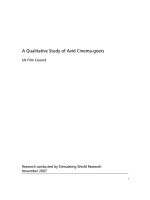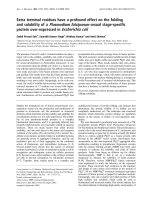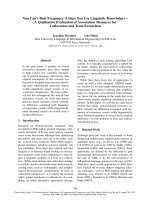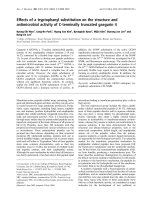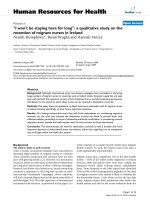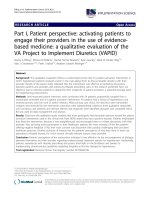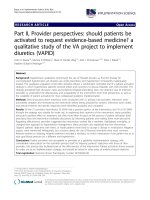transitions during adolescence a qualitative exploration of the developmental and healthcare transition experiences of adolescents with epilepsy
Bạn đang xem bản rút gọn của tài liệu. Xem và tải ngay bản đầy đủ của tài liệu tại đây (2.72 MB, 125 trang )
Glasgow Theses Service
Cookson, Jennifer (2014) Transitions during adolescence: a qualitative
exploration of the developmental and healthcare transition experiences of
adolescents with epilepsy. D Clin Psy thesis.
Copyright and moral rights for this thesis are retained by the author
A copy can be downloaded for personal non-commercial research or
study, without prior permission or charge
This thesis cannot be reproduced or quoted extensively from without first
obtaining permission in writing from the Author
The content must not be changed in any way or sold commercially in any
format or medium without the formal permission of the Author
When referring to this work, full bibliographic details including the
author, title, awarding institution and date of the thesis must be given
1 | P a g e
Transitions During Adolescence: A qualitative exploration of the
developmental and healthcare transition experiences of adolescents with
epilepsy.
And
Clinical Research Portfolio
Volume I
(Volume II bound separately)
Jennifer Cookson (MA Honours, MA, MSc)
Institute of Health and Wellbeing
College of Medical, Veterinary and Life Sciences
University of Glasgow
October 2014
Submitted in partial fulfilment of the requirements for the degree of Doctorate in
Clinical Psychology (DClinPsy)
2 | P a g e
Table of Contents
Volume I
Page
Declaration of Originality
Acknowledgements
Chapter 1: Systematic Review
Perceptions of Stigma in Adolescents with Epilepsy: A Systematic Review
Chapter 2: Major Research Project
Transitions During Adolescence: A qualitative exploration of the
developmental and healthcare transition experiences of adolescents with
epilepsy.
Chapter 3: Advanced Clinical Practice I – Reflective Critical Account
Reformulating Formulation (Abstract only – for full Account see Volume II)
Chapter 4: Advanced Clinical Practice II – Reflective Critical Account
Reflecting on the systems of Psychological Provision (Abstract only – for full
Account see Volume II)
Appendices
3
4
5
36
77
78
79
3 | P a g e
Declaration of Originality Form
This form must be completed and signed and submitted with all assignments.
Please complete the information below (using BLOCK CAPITALS).
Name JENNIFER COOKSON
Student Number 0105838
Course Name Doctorate in Clinical Psychology
Assignment Number/Name Clinical Research Portfolio
An extract from the University’s Statement on Plagiarism is provided overleaf. Please
read carefully THEN read and sign the declaration below.
I confirm that this assignment is my own work and that I have:
Read and understood the guidance on plagiarism in the Doctorate in Clinical Psychology
Programme Handbook, including the University of Glasgow Statement on Plagiarism
Clearly referenced, in both the text and the bibliography or references, all sources used in the
work
Fully referenced (including page numbers) and used inverted commas for all text quoted from
books, journals, web etc. (Please check the section on referencing in the ‗Guide to Writing
Essays & Reports‘ appendix of the Graduate School Research Training Programme handbook.)
Provided the sources for all tables, figures, data etc. that are not my own work
Not made use of the work of any other student(s) past or present without acknowledgement.
This includes any of my own work, that has been previously, or concurrently, submitted for
assessment, either at this or any other educational institution, including school (see overleaf at
31.2)
Not sought or used the services of any professional agencies to produce this work
In addition, I understand that any false claim in respect of this work will result in disciplinary
action in accordance with University regulations
DECLARATION:
I am aware of and understand the University‘s policy on plagiarism and I certify that this assignment is
my own work, except where indicated by referencing, and that I have followed the good academic
practices noted above
Signature: JENNIFER COOKSON. .Date: 16.10.14
4 | P a g e
Acknowledgements
I would like to thank the participants who took part in this study. Thank you for taking
the time to share your experiences with me. Without you the study would not have
been possible.
I would like to thank my supervisors Dr. Alison Jackson and Dr. Nicola Scott for all
their support, expert guidance and advice throughout the study. I would also like to
thank Professor Andrew Jahoda for his advice.
A very special thank you goes to my mum and dad who have always supported me
through my studies, despite how long it has taken! Thank you for always believing in
me and providing me with love, support and proof reading! I love you both very
much.
Last but definitely not least, I would like to thank my wonderful husband Andrew who
has survived the last three years with the patience of a saint! I don‘t know what I
would have done without your love and support. Thank you for always encouraging
and believing in me, especially during the times when I didn‘t believe in myself. I love
you very much and I promise, no more studying!
5 | P a g e
Chapter One: Systematic Review
Perceptions of Stigma in Adolescents with Epilepsy:
A Systematic Review
Word Count: 7,545
Correspondence to:
Jen Cookson
Mental Health & Wellbeing
Gartnavel Royal Hospital
1055 Great Western Road
Glasgow
G12 0XH
Email:
Prepared in accordance with the requirements for submission to Child: Care, Health and
Development (See Appendix 1.1)
6 | P a g e
Abstract
Background: Research suggests that adolescents with epilepsy experience
significant stigmatisation. This stigmatisation has been associated with peer
rejection, educational underachievement and significant psychosocial difficulties.
Factors including age, gender, seizure severity and age of onset have previously
been reported to influence the extent of stigma perceived by adolescents with
epilepsy. This review explored further the perceived stigma experiences of
adolescents with epilepsy.
Methods: A systematic literature search was conducted using MEDLINE,
Psychology and Behavioural Sciences Collection, PsychINFO, PsychARTICLES,
CINAHL, the Cochrane Library and Science Direct to identify relevant studies.
Articles were screened against a priori inclusion criteria. The quality of included
studies was assessed.
Results: Seven studies met the inclusion criteria. Increasing age, male gender, less
epilepsy knowledge, increased number of drugs taken, increased seizure severity,
increased worry and negative perceptions of epilepsy were reported to significantly
impact perceived stigma.
Discussion: Some significant findings in this review paralleled findings from the
previous review, in particular, associations between increased age and epilepsy
severity. Additional significant associations were reported, however variation in
methodology meant only tentative comparisons could be made. Cultural variation
needs to be considered when appraising these findings. Further research is needed
in this area.
7 | P a g e
Introduction
The currently recognised definition of epilepsy, developed by the International
League Against Epilepsy is: ―a disease of the brain defined by any of the following
conditions: (1) At least two unprovoked (or reflex) seizures occurring more than 24
hours apart; (2) one unprovoked (or reflex) seizure and a probability of further
seizures similar to the general recurrence risk (at least 60%) after two unprovoked
seizures, occurring over the next 10 years; (3) diagnosis of an epilepsy syndrome”
(Fisher et al., 2014, p. 475). It is reported to be the most common neurological
condition in individuals under the age of 18 years in the UK (MacLeod & Appleton,
2007).
Adolescents with epilepsy are reported to experience a substantial amount of stigma
due to their diagnosis (Jacoby et al., 2008). For example, Hirfanoglu et al. (2009)
found that up to 40% of adolescents (N=533) with epilepsy reported feeling
stigmatised by their peers. Stigma has had a number of definitions. Goffman (1963)
described it as a status loss or discreditation caused by having a characteristic that
is culturally defined as being different or undesirable. In relation to health conditions
Weiss and Ramakrishna (2006) described stigma as ―a social process or related
personal experience characterised by exclusion, rejection, blame, or devaluation that
results from experience or reasonable anticipation of an adverse social judgement
about a person or group identified with a particular health problem” (p.536). This
latter definition makes a crucial change to the understanding of stigma as it includes
not only direct experiences of adverse judgement, but also the anticipation of
adverse judgement. Muhlbauer (2002) conceptualised three main forms of stigma:
internalised, interpersonal, and institutional. Internalised stigma reflects the individual
with the health condition‘s thoughts, feelings and concerns about being different.
Interpersonal stigma is when an individual is treated differently and negatively within
their interactions with others because of their health condition. Institutionalised
stigma is understood as the indirect differential treatment within wider society of
certain groups with particular health conditions, for example in the use of clinical
terminology to describe them (―epileptic‖ rather than a person with epilepsy), or in
exclusion from activities or insurance categories.
8 | P a g e
Adolescence is a turbulent period of drastic physical, social and emotional change
during which identity and self-definition are developed (Devinsky et al., 1999) and
independence and autonomy are fostered (Appleton & Neville, 1999; Erikson, 1968).
Epilepsy can have a significant psychosocial impact on adolescents during this
developmental stage. Adolescents with epilepsy are expected to incorporate
additional knowledge and skills whilst also negotiating the same challenges as their
peers (Sheth, 2002). Stigmatisation is one of the many factors that can influence
their successful negotiation through this (Austin et al., 2014). Since the turn of the
century, there has been an increased focus on understanding the impact of stigma
on the development and life experiences of adolescents with epilepsy. This has
included studies focussing on adolescents with epilepsy and adolescents within the
general population in an attempt to understand the different forms of stigma
described above (e.g. Austin et al., 2002). Studies have shown that adolescents with
epilepsy who experience stigma are more vulnerable to developing psychological
difficulties such as low self-esteem (Baker et al., 2005); symptoms of anxiety and
depression (Adewuya & Ola, 2005); social adjustment problems (Baker et al., 2005),
and higher rates of suicide (Zamani et al., 2012). Epilepsy related stigma has also
been associated with peer rejection, school avoidance and academic
underachievement (Buhs & Ladd, 2001). An Epilepsy Foundation Survey (N=19,441)
found that a significant proportion of adolescents in the general population held
negative perceptions of people with epilepsy and 75% thought teenagers with
epilepsy would be more likely to be bullied (Austin et al., 2002). This highlights a
significant example of institutionalised stigma, which has been associated with
limited knowledge and less familiarity of epilepsy within this age group internationally
(Ani et al., 2011; Rho et al., 2010; Hirfanoglu et al., 2009).
Two systematic reviews to date have explored the impact of stigma on adolescents
with epilepsy. MacLeod and Austin (2003) extrapolated findings from six studies. The
studies included in their review found significant positive correlations between
perceived stigma and age and stigma and duration of epilepsy and a negative
correlation between perceived stigma knowledge of epilepsy. They also found
stigmatising perceptions towards epilepsy across adolescents in the general
population. They concluded that more in-depth research was required to fully
understand the experiences of stigma for adolescents with epilepsy. McEwan et al.
9 | P a g e
(2004) systematically reviewed the contribution of qualitative research in
understanding the impact of epilepsy on the quality of life in children and
adolescents. Only one study met inclusion criteria, however, from this and the
process of excluding the remaining studies, they concluded that more emphasis
needed to be placed on the views of those with epilepsy rather than gathering
information from proxy reports from parents and teachers. There has been a
significant increase in research being conducted in this area since these reviews
were conducted, however no review was identified that looked specifically at
quantitative research since 2003 exploring perceived stigma in adolescents with
epilepsy.
Review Aim
To systematically review perceived stigma in adolescents with epilepsy.
10 | P a g e
Method
Selection Criteria
To be included in this review, studies had to meet the following criteria:
1) Include adolescent participants (aged 10-19 in accordance with WHO
definition, 2013);
2) Participants with epilepsy;
3) Direct measuring and reporting of stigma as perceived by adolescents;
4) Studies published in English peer reviewed journals between January 2002
and July 2014;
5) Quantitative methodology.
Studies were excluded if they met any of the following criteria:
1) Translation and/or validation of psychometric measures;
2) Proxy reporting of adolescent stigma;
3) Review papers;
4) Case studies;
5) Studies using qualitative methodology.
Search strategy
A comprehensive search was conducted in July 2014 using the following databases:
Science Direct, MEDLINE, CINAHL, PsychINFO, PsychARTICLES, Psychology and
Behavioural Sciences Collection and the Cochrane Library. The search strategy
included the following Medical Subject Headings (MeSH) headings or keywords: 1)
epilepsy or epilepsies; and 2) adolescent or adolescence or young person; and 3)
stigma or quality of life or QOLIE-AD-48 or health related quality of life or HRQOL;
and 4) measuring or measurement or instrument. Key journals including Seizure,
Epilepsia, Epilepsy and Behavior, and reference lists of identified papers were hand
searched for additional references.
11 | P a g e
Quality Assessment
The quality of included studies was assessed using The Crowe Critical Appraisal
Tool [CCAT] (Crowe & Sheppard, 2011). The most updated version [Version 1.4]
(Crowe, 2013) contains 22 items in eight categories. The items are rated on a
nominal scale as Present, Absent or Not Applicable and given a score out of five for
each category, a total score and a total percentage (Appendix 1.2). An independent
reviewer rated all included studies using the same quality rating scale. There was an
87% agreement between researchers. Any disagreements were resolved through
discussions. The CCAT does not include qualitative descriptions of scores, however
other critical appraisal tools state that >75% is considered good, >50% is considered
acceptable and <50% is considered poor (e.g. Walsh & Downe, 2006). These
descriptors will be considered in the Quality Review section below.
12 | P a g e
Results
Results of search strategy
The database search identified 2130 articles. 2015 were excluded on the basis of
their title and nine duplicates were removed. Abstracts, full text and reference lists of
the remaining 106 articles were reviewed using the full inclusion criteria. Hand
searches of the reference lists generated a further 23 studies therefore 129 full texts
were reviewed. This resulted in the exclusion of a further 122 studies. A total of
seven studies met the full inclusion criteria measuring perceived stigma of
adolescents with epilepsy. The study selection process is detailed in Figure 1.
Figure 1: Flow diagram of study selection process
Databases searched:
CINAHL, Science Direct, Cochrane
Library, PsychINFO, PsychARTICLES,
Psychology and Behavioural Science
Collection, MEDLINE, Pubmed.
(n=2130)
Records Screened
(n=2130)
Records excluded following
review of title
(n=2015)
Full text of articles reviewed
for eligibility
(n=115)
Duplicates removed
(n=9)
Articles potentially relevant
for the current review
(n=129)
Full text articles excluded
(n=122)
Reasons for exclusion:
1. Qualitative methodology
2. Review articles
3. Not directly measuring
stigma
4. Only participants under 10
or over 19 years of age
5. Not English
6. Not Primary research
7. Not peer reviewed
publication
8. Validation or translation of
measures
9. Only measuring stigma by
proxy
Studies included in
quantitative synthesis
(n=7)
Hand searches
of references
from full text
articles
(n=23)
13 | P a g e
Overview of the articles
Of the seven studies identified for inclusion in this review, one surveyed the
knowledge of, attitudes to and perceptions of epilepsy in children with epilepsy and
their families and compared this is to quality of life and stigmatisation (Hirfanoglu et
al., 2009), five measured the concept of stigma as it is associated with overall health
related quality of life [HRQOL] (Zamani et al., 2014; Zashikhina & Hagglof, 2014; Wu
et al., 2010; Stevanovic, 2007; Benavente-Aguilar et al., 2004) and one measured
the relationship between parental psychopathology and the concept of stigma as it
associated with overall HRQOL in adolescents with epilepsy (Adewuya, 2006).
Stigma in the context of health related quality of life of individual‘s with epilepsy is
understood as ―the extent to which people with epilepsy are separated from society
on the basis of the meanings that are attached to the term “epilepsy”‖ (Reiss &
Meinardi, 2002, p.s35). In the development of HRQOL scales for epilepsy, stigma
related items refer specifically to the impact of social isolation, discrimination and the
perceived impact of epilepsy on daily activities and life fulfilment (Ablon, 2002;
Jacoby, 2002; Cramer et al., 1999). For the purpose of this review, statistics and
findings relating to perceived stigma in adolescents with epilepsy were extracted
from studies. Table 2 provides a detailed summary of the included studies.
Quality Review
Table 1 provides a detailed summary of the scores obtained by each study including
domain scores, total scores and total percentages. Using the qualitative descriptors
detailed above, all studies were considered good. All studies scored four or five out
of five for preliminaries (defined as abstract, title, aims and style), introduction,
design and sampling other than Wu et al. (2010). This means that studies reported
summaries of current knowledge, primary and secondary objectives and appropriate
research design and sampling procedures. Three studies scored lower in the Ethical
Matters category as they did not report enough items (Zamani et al., 2014;
Zashikhina & Hagglof, 2014; Stevanovic, 2007). This category required studies to
state participant ethics, including informed consent, privacy and confidentiality, and
researcher ethics, including ethical approval, funding, conflicts of interest,
subjectivities and relationships with participants. Two studies scored lower in the
14 | P a g e
discussion section as they did not report study limitations and future research
prospects (Zashikhina & Hagglof, 2014; Hirfanoglu et al., 2009).
Table 1: Quality Assessment Results
CCAT Scores
Study
Country
Preliminaries
Introduction
Design
Sampling
Data Collection
Ethical Matters
Results
Discussion
Total
Total %
Adewuya (2006)
Nigeria
4/5
5/5
5/5
4/5
3/5
4/5
4/5
4/5
33/40
83%
Benavente-Aguilar
et al. (2004)
Spain
4/5
4/5
4/5
5/5
4/5
5/5
4/5
4/5
34/40
85%
Hirfanoglu et al.
(2009)
Turkey
5/5
4/5
5/5
4/5
4/5
4/5
4/5
3/5
33/40
83%
Stevanovic (2007)
Serbia
5/5
5/5
4/5
4/5
4/5
1/5
5/5
4/5
32/40
80%
Wu et al. (2010)
China
5/5
3/5
5/5
5/5
5/5
5/5
4/5
5/5
37/40
92%
Zamani et al. (2014)
Iran
5/5
5/5
4/5
5/5
4/5
3/5
4/5
5/5
35/40
88%
Zashikhina & Hagglof
(2014)
Russia
5/5
5/5
5/5
4/5
3/4
2/5
4/5
3/5
31/40
78%
Stigma Outcome Measures in Included Studies
Quality of Life in Adolescents with Epilepsy Inventory [QOLIE-AD-48]: This is a 48
item valid and reliable self-report measure of health related quality of life (HRQOL),
specifically for adolescents with epilepsy (Cramer et al., 1999). It incorporates eight
subscales: Health Perceptions, Epilepsy Impact, Memory/Concentration, Physical
Functioning, Stigma, Social Support, School Functioning and Attitudes towards
Epilepsy. Scores for each item are obtained from a Likert scale. Forty-two items
have a 5 point Likert scale (1 for the worse and 5 for the best status) and 6 items
have a 4 point Likert Scale (1 for the worse and 4 for the best status). Raw scores
are translated into scores on a 0-100 response scale. The total score was
determined by multiplying the mean by the relative weight for each domain (See
Table 3 below). Higher scores indicate better HRQOL. For the purpose of this
review, stigma scores and significant associations were extracted from studies.
Lower perceived stigma is indicated in this measure by a higher score.
15 | P a g e
Table 3: Relative weight for each domain of the QOLIE-AD-48
Domain
Weight
Domain
Weight
1. Epilepsy Impact
0.31
5. Stigma
0.13
2. Memory/concentration
0.17
6. Social Support
0.02
3. Attitudes
0.09
7. School Behaviour
0.06
4. Physical Function
0.09
8. Health Perceptions
0.12
Children’s Questionnaire: Hirfanoglu et al. (2009) used a 46 item questionnaire they
developed to measure children‘s general knowledge and impact of epilepsy including
attitude, perception, stigmatisation, social support, self-esteem, school and
depression. The first ten questions collected demographic details including age,
gender, duration of disease, anti-epileptic drugs, schooling, parental employment
status and number of siblings. Of the remaining questions 12 items measured
general knowledge on a 4 point Likert scale (1-yes, 2-no, 3-probably not, 4-I don‘t
know) and 24 items measured impact on a 5 point Likert scale (1-nothing, 2-hardly
any, 3-a few, 4-more often than not, 5-a lot/often). The scale is reported to have
good content validity and internal consistency reliability (α=0.92).
16 | P a g e
Table 2: Summary of Included Studies
Study
Demographics*
Design
Measure
#
Analysis
Stigma Related
Findings
Adewuya
(2006)
N=86
50 male, 36 female
Mean Age: 14.5 ±2.1 yrs
Age Range: 12-18 yrs
Mean duration: 6.5±2.2 yrs
Mean onset: 8.8±3.2 yrs
Cross
Sectional
QOLIE-AD-48
(Yoruba translation)
GHQ-30
^
SRAS
~
SRDS
+
Multi-variate
regression analysis
Correlations
Mean stigma score: 65.99±11.31
Significant Associations:
1) Adolescent stigma & parental GHQ-30 score (r=0.305,
P=0.01). Higher perceived stigma is associated with higher
GHQ scores.
2) Adolescent stigma & parental SRDS score (r=0.584, P=0.01)
Higher perceived stigma is associated with higher SRDS
scores.
Benavente-
Aguilar et
al. (2004)
N=66
36 male, 30 female
Mean age: 15 yrs
Age range: 10-19 yrs
Mean onset: 7.2 yrs
Mean duration: 8.1 yrs
Cross
Sectional
QUOLIE-AD-48
(Spanish version)
Veterans Administration
Neurotoxicity Rating
Scale
T-test
ANOVA
Socio demographic
variables
Mean stigma score: 86±20.1
Significant differences:
1) Stigma scores in mild & moderate/severe epilepsy (P<0.01).
Higher perceived stigma was reported by those with more
severe epilepsy.
Hirfanoglu
et al.
(2006)
N=220 (children)
95 females, 125 males
Mean age: 13.5±3.2 yrs
Age range: 8-17 yrs
Mean onset: not provided
Mean duration: 4.43±3.96
Cross
Sectional
Author developed scale
Descriptive
Statistics
Correlations
41.2% reported feeling stigmatised by friends.
Significant Associations:
1) stigma & age (r=0.256, P=0.0001) – increasing age is
associated with higher levels of perceived stigma.
2) Stigma & symptoms of depression (r=0.276, P=0.0001) – as
symptoms of depression increase, perceived stigma
increases
3) Stigma & negative perception (r=0.195, P=0.004) – as
negative perception of epilepsy increases, perceived stigma
increases.
4) Stigma & perceived lack of social support (r=0.266, P=0.000)
– as perceived lack of social support increases, perceived
stigma increases.
5) Stigma & knowledge (r=-0.180, P=0.008) – less knowledge is
associated with higher perceived stigma.
6) Stigma & self-esteem (r=-0.150, P=0.026) – lower self-
esteem is associated with higher perceived stigma.
Stevanovic
(2007)
N=71
39 males, 32 females
Mean age: 15.1±2.15yrs
Cross
Sectional
QOLIE-AD-48 (Serbian
Version)
Descriptive
Statistics
Mean stigma score:
1) Total: 82.96±19.54
2) Males: 81.1±21.21, (95%Confidence Interval: 74.21-87.96)
17 | P a g e
Age range: 11.5-18 yrs
Mean onset:5.16±3.85 yrs
Mean duration: 11.5±5.12
yrs
Correlations
Regression
Analysis
3) Females: 85.24±16.97 (95%Confidence Interval: 79.12-
91.36).
Significant Associations:
1) Stigma & total HRQOL score (r=0.6, P=≤0.05)
2) Stigma & health perception (r=0.25, P=≤0.05)
3) Stigma & epilepsy impact (r=0.57, P=≤0.05)
4) Stigma & memory/concentration (r=0.25, P=≤0.05)
5) Stigma & physical functioning (r=0.28, P=≤0.05)
6) Stigma & school behaviour (r=0.24, P=≤0.05)
7) Stigma & attitudes towards epilepsy (r=0.42, P=≤0.05).
For the above stigma associations, a higher stigma score
represents a better stigma quality of life score i.e. better quality
of life or less perceived stigma. So each of the factors are
significantly associated with better stigma related quality of life
i.e. lower perceived stigma.
Predictors of stigma
1) Number of drugs taken (β=0.233, P<0.001, F value = 15.47,
Variance = 31%)
2) Epilepsy concern (β=-0.01, P=0.042)
Wu et al.
(2010)
N=47
21 female, 26 male
Mean Age: not provided
Age range:11-17 yrs
Mean onset: 11.34±3.38 yrs
Median duration: 2 yrs
Case
control
study
QOLIE-AD-48 (Chinese
version)
T-tests
Step wise linear
regression analysis
Mean stigma score: 62.9±26.4
Predictors of Stigma:
1) Duration in years (β=-0.395, P=0.006) AEDS (β=0.304,
P=0.031)
2) Onset age (β=0.339, P=0.035)
Zashikhina
& Hagglof
(2006)
Epilepsy sample :
N=47
19 males, 28 females
Mean age: 14.95 yrs
Age range: 13-16 yrs
Mean onset: not provided
Mean duration: not
provided
Cross
Sectional
QOLIE-AD-48 (Russian
translation)
Descriptive
Statistics
Regression
analysis
Mean stigma scores:
1) Total: 58.9±20.7
2) Males: 52.92±13.54
3) Females = 64.48±23.63;
Predictors of Stigma:
1) Gender (β=0.28, t(47)=1.98, P<0.05, R
2
=0.06).
Zamani et
al. (2014)
N=187
101 males, 86 females.
Mean age: 14.28 ±2.54 yrs
Age range: 11-17 yrs
Mean onset: 7.28±3.4 yrs
Mean duration: 7.01±3.14
yrs
Cross
Sectional
QOLIE-AD-48 (Persian
Version)
Descriptive
Statistics
Correlations
Mean stigma score: 52.55±19.71
Significant correlations:
1) Stigma & age (r=-0.40, P<0.001) – as age increases stigma
related quality of life decreases, i.e. perceived stigma
increases
2) Stigma & number of drugs (r=-0.151, P=0.041) – as the
18 | P a g e
number of drugs taken increases, stigma related quality of
life decreases, i.e. perceived stigma increases
3) Stigma & frequency of seizures (r=-0.201, P=0.006) – as the
frequency of seizures increases, stigma related quality of life
decreases i.e. perceived stigma increases.
*Standard Deviations are provided where reported in studies.
#
Translation refers to a validated translation, version refers to local translation provided specifically for the study including appropriate independent back translations
^
General Health Questionnaire (Goldberg & Hiller, 1979)
~
Zung‘s Self-Rating Anxiety Scale (Zung, 1971)
+
Zung‘s Self-Rating Depression Scale (Zung, 1965
19 | P a g e
Description of Studies and Key Stigma Related Findings
Hirfanoglu et al. (2009) used their Children‘s Questionnaire to study associations
between knowledge, quality of life and stigmatisation of Turkish children (8-17 years)
with epilepsy (N=220) and their parents (N=313). Participants were recruited from a
paediatric neurology department. Patients with intellectual impairment (defined as an
IQ score <80 on WISC-R), vision or hearing impairments, a diagnosis of a
progressive neurodegenerative disorder or who had participated in a pre-test, were
excluded from the study. Forty one percent of children reported feeling stigmatised
by their friends. Significant correlations were found between perceived stigma score
and age (r=0.256, P=0.0001); knowledge (r=-0.187, P=0.0008); number of siblings
(r=0.199, P=0.003); negative perception of epilepsy (r=0.195, P=0.004); perceived
lack of support (r=0.266, P=0.000); and self-esteem (r=-0.150, P=0.026). They also
reported increased perceived stigmatisation scores in children with at least one
unemployed parent (P=0.015). Authors acknowledge that, as this is the first study in
Turkey to investigate this phenomenon, further, more comprehensive studies are
required to validate their findings and to allow comparison with control groups.
Adewuya (2006) investigated the relationship between HRQOL and parental
psychopathology in 86 adolescents with epilepsy (12-18 years). Participants were
recruited from two specialist tertiary neuropsychiatry outpatient clinics and were
required to have been on drug treatment for a least one year. Exclusion criteria
included severe cognitive disabilities (defined as severe of profound learning
disability) and being non-verbal. HRQOL was measured using a Yoruba translation
of the QOLIE-AD-48. The mean score of perceived stigma in adolescents was 65.99
(±11.31). Significant correlations were found between adolescent stigma scores and
parent GHQ-30 (r=0.305, P=0.01) and SRDS (r=0.584, P=0.01) scores. The author
acknowledged the use of a hospital based sample, restricted age range and
exclusion of individuals with learning disabilities as potential limitations of the study.
A further difficulty is the lack of control group as parental psychopathology could also
impact adolescents without epilepsy. Therefore it is not possible to definitively
determine whether the difficulties experienced by these adolescents are related to
their epilepsy or their parent‘s psychopathology. Parental psychopathology was
mostly measured in mothers in the study (94.2%). Further exploration of fathers‘
20 | P a g e
psychopathology and the use of a matched control group would perhaps allow these
factors to be investigated in more depth.
Benavente-Aguilar et al., (2004) examined the HRQOL of a community sample of
adolescents (10-19 years) with epilepsy (N=66). Participants were identified from
hospital registers and were required to meet the following inclusion criteria: a
diagnosis of active epilepsy (defined as at least one seizure in the last five years);
illness duration of one year or more; not living in an institution and ability to read
Spanish. Exclusion criteria included co-morbid psychiatric or other physical illness,
deafness, blindness or patients who had undergone brain surgery in the previous
year. This is the only study in the review that did not state cognitive impairment or
learning disability as exclusion criteria. HRQOL was measured using the Spanish
Version of the QOLIE-AD-48 (Benavente et al., 2002 [Spanish]). The mean stigma
score was 86 (±20.1) overall, 90 (±14.2) in participants with mild epilepsy and 72.2
(±27.2) in participants with moderate to severe epilepsy. A significant difference was
reported been stigma in mild versus moderate or severe epilepsy groups (P<0.01).
This study attempted to capture the total population of young people with epilepsy in
this province; however they acknowledge that those who do not access services will
have been unintentionally excluded. The authors also acknowledged that
associations found between increased severity and overall HRQOL (including
stigma) may be confounded by the links between severity and increased exposure to
neurotoxicity due to the subsequent increase in medications required by this sub-
sample.
Stevanovic (2007) evaluated HRQOL of Serbian adolescents (11-18 years) with well
controlled epilepsy (N=71). Participants were recruited from a Health Care institute
and Neurology and Psychiatry clinic. To be included participants were required to
have had active, uncomplicated epilepsy (defined as no seizures for more than one
year) for more than five years. Participants with additional neurological or psychiatric
disorders, major neuropsychological deficits or other chronic conditions, had
undergone significant therapy or EEG changes, had been hospitalised or
institutionalised for any reason or lived away from their parents and who had a failing
grade or dropped out of school were excluded. HRQOL was measured using the
Serbian Version of the QOLIE-AD-48 (Stevanovic et al., 2005). The mean stigma
score was 82.96 (±19.4) overall, 81.1 (±21.21) for males and 85.24 (±16.97) for
21 | P a g e
females. Significant correlations were found between stigma and overall HRQOL
score (r=0.6, P=≤0.05); health perception (r=0.25, P=≤0.05); epilepsy impact (r=0.57,
P=≤0.05); memory/concentration (r=0.25, P=≤0.05); physical functioning (r=0.28,
P=≤0.05); school behaviour (r=0.24, P=≤0.05); and attitude toward epilepsy (r=0.42,
P=≤0.05). Stigma was reported to be significantly predicted by the number of anti-
epileptic drugs (AEDs) taken (β=0.233, P<0.001, F=15.47, Variance =31%) and the
level of epilepsy concern (β=-0.01, P=0.042). The cross sectional design and
absence of group comparisons are considered a potential limitation for
generalisability by the authors. The specific inclusion and exclusion criteria are also
considered a generalisability limitation. They also acknowledged that previous
studies in well-controlled epilepsy have focused on quality of life rather than HRQOL
therefore making comparisons difficult.
Wu et al. (2010) conducted a case control study of 47 pairs of Chinese adolescents
(11-17 years) with epilepsy and matched normal controls to explore quality of life and
related factors. Participants with epilepsy were recruited from a neurology outpatient
clinic in Shanghai. They were required to be between 11 and 17 years of age, able to
read Chinese, experienced active epilepsy within the previous six months and have
an available parent who spoke and read Chinese. Individuals were excluded if they
had undergone epilepsy surgery in the previous year, had additional neurological or
psychiatric disorders, had major neuropsychological deficits or other conditions.
Forty seven adolescents without epilepsy or any other chronic conditions were
matched one-to-one to epilepsy cases by sex and age to within a year. HRQOL in
adolescents with epilepsy was measured using the Chinese Version of the QOLIE-
AD-48 (Wang et al., 2009). Quality of life in controls was measured using three
domains unrelated to epilepsy (memory/concentration, physical functioning and
social support). The mean stigma score in case participants was 62.9 (±26.4).
Stigma were reported to be significantly predictable by duration of epilepsy (β=-
0.395, P=0.006); number of AEDs taken (β=0.304, P=0.031); and onset age
(β=0.339, P=0.035). The authors acknowledged that the economic level and
availability of resources for participants in Shanghai may not be generalizable to
rural China and therefore results may have a positive bias in terms of experiences of
stigma. In addition they noted that due to their exclusion of surgical patients and
22 | P a g e
those with psychiatric co-morbidities, it is difficult to generalise the findings to
patients with new onset or chronic epilepsy or to those with co-morbidities.
Zamani et al. (2014) conducted an analytical cross sectional study of the HRQOL in
Iranian adolescents (11-17 years) with epilepsy (N=197). Participants were recruited
from a Children‘s Hospital within a 14 month period. A diagnosis of epilepsy and
attendance at the hospital are the only stated inclusion criteria in the study. HRQOL
was measured using the Persian version of the QOLIE-AD-48 (Dashtebozorgi et al.,
2010). The mean score of perceived stigma was 52.55 (±19.71). They reported that
65.8% of the participants never spoke to their friends or teachers about their
epilepsy. Significant associations were found between stigma and age (r=-0.40,
P<0.0001); number of drugs taken (r=-0.151, P=0.041); and frequency of seizures
per year (r=-0.201, P=0.006). Age and seizure concern were found in this study to be
a significant predictors of stigma (β=-0.286, P=0.000, F=7.003 [age]; β=0.213,
P=0.002, F=7.003 [seizure concern]). They compared stigma scores to previous
studies using international translations of QOLIE-AD-48 and found lower scores in
their sample than in previous studies suggestive of higher perceived stigma. The
authors acknowledge the sample size as a limitation. The lack of reported exclusion
criteria also makes it impossible to determine the homogeneity of the sample and
make comparison with other studies difficult.
Zashikhina and Hagglof (2014) conducted a cross sectional survey to explore
HRQOL in adolescents (13-16 years) with chronic illness in Northern Russia
(N=173). Participants were recruited from child outpatient clinics and were required
to have received their diagnosis at least one year prior to the study. Individuals were
excluded if they had an additional diagnosis of ―mental retardation‖, resided in an
institution or had more than one chronic condition. The sample consisted of 47
adolescents with epilepsy, 50 with Type 1 Diabetes, 49 with asthma and their
parents. HRQOL in adolescents with epilepsy (N=47) was measured using a
Russian translation of the QOLIE-AD-48. The mean stigma score was 59.8 (±20.7)
overall (N=47), 64.48 (±23.63) for females (N=29) and 52.92 (±13.54) for males
(N=19). Gender was found to be a predictor of stigma in their sample (β=0.28,
t(47)=1.98, P<0.05, R
2
=0.06). Authors acknowledged that the cross sectional design
and sample size were potential limitations. They also stated that the inability to make
23 | P a g e
comparisons between condition groups or with controls made the findings difficult to
generalise.
Perceived Stigma in Adolescents with Epilepsy
Significant correlations and predictive factors for stigma were reported across
studies. Age, epilepsy severity and knowledge and support needs were directly
correlated with perceived stigma. These will be considered in turn. Reported
predictive factors will then be considered. Finally, additional significant findings will
be considered.
Perceived Stigma:
There was variation reported in average stigma scores across the studies indicative
of varying levels of perceived stigma across samples and sample characteristics.
Table 4 details the average stigma scores reported by studies using the QOLIE-AD-
48 from highest (indicating higher HRQOL in this domain, that is lower perceived
stigma) to lowest (indicating lower HRQOL and higher perceived stigma).
Table 4: Average Perceived Stigma in Studies using QOLIE-AD-48
Study
Country
Mean Stigma Score
Benavente-Aguilar et al. (2004)
Spain
86±20.1
Stevanovic (2007)
Serbia
82.96±19.54
Adewuya (2006)
Nigeria
65.99±11.31
Wu et al. (2010)
China
62.9±26.4
Zashikhina & Hagglof (2014)
Russia
58.9±20.7
Zamani et al. (2014)
Iran
52.55±19.71
The results suggest that adolescents with epilepsy in Spain and Serbia experience
the least perceived stigma (indicated by a higher score) and those in Iran experience
the most (indicated by lower score). The variation in scores needs to be considered
carefully as the homogeneity of sample characteristics and the wide cultural variation
in the studies make generalisability less robust.
24 | P a g e
Perceived Stigma and Age:
Two studies (Zamani et al, 2014; Hirfanoglu et al., 2009) reported significant
correlations between level of perceived stigma and the age of participants. Both
studies reported that an increase in age was correlated with an increase in perceived
stigma. Due to the scoring mechanisms or the outcome measures in each study this
was described as an inverted correlation in Zamani et al.‘s (2014) study (that is, as
age increases stigma related quality of life decreases [r=-0.40, P<0.001]) and as a
positive correlation in Hirfanoglu et al.‘s (2009) study (that is, as age increases
perceived stigma score increases [r=0.256, P=0.0001]). This was thought by the
authors to be related to the increased importance of peer acceptance and social
identity as participants progressed through adolescence.
Perceived Stigma and Epilepsy Severity:
Two studies (Zamani et al., 2014; Benavente-Aguilar et al., 2004) reported significant
correlations between stigma and epilepsy severity. Benavente-Aguilar et al. (2004)
reported a positive correlation between increased perceptions of stigma and
increased severity (P<0.01-full statistic not stated). Zamani et al. (2014) reported this
as an inverse correlation between level of perceived stigma and increased seizure
activity (r=-0.201, P=0.006). Neither study reported the specific diagnosis of
epilepsy.
Significant Predictors of Perceived Stigma:
Four studies used regression analysis to determine significant predictors of
perceived stigma in adolescents with epilepsy. Five factors were determined:
number of anti-epileptic drugs (Stevanovic, 2007 [β=0.233, P=0.0001, F=15.47,
variance=31%]; Wu et al., 2010 [β=0.304, P=0.031]); epilepsy concern (Stevanovic,
2007 [β=-0.01, P=0.042]); duration of epilepsy (Wu et al., 2010 [β=-0.395, P=0.006]);
gender (Zashikhina & Hagglof, 2014 [β=0.28, t(47)=1.98, P<0.05, R
2
=0.06]); and
onset age (Wu et al., 2010 [β=0.339, P=0.035]).
Additional Significant Findings:
Hirfanoglu et al. (2009) reported significant correlations between higher levels of
perceived stigma with higher negative perceptions of epilepsy (r=0.195, P=0.004),


